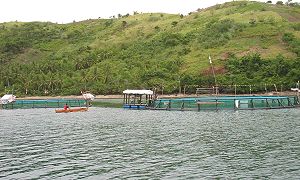Marine parks expansion
program seen to energize further the fisheries sector
By Philippine Information Agency (PIA 8)
February
8, 2007
 TACLOBAN CITY, Leyte
– Even as Region 8 is in the middle of preparations for the first
Eastern Visayas Mariculture Parks Congress which will be participated
in by both local and international stakeholders, the Department of
Agriculture has announced the expansion of mariculture parks in
coastal areas across the country in order to energize further the
fisheries sector.
TACLOBAN CITY, Leyte
– Even as Region 8 is in the middle of preparations for the first
Eastern Visayas Mariculture Parks Congress which will be participated
in by both local and international stakeholders, the Department of
Agriculture has announced the expansion of mariculture parks in
coastal areas across the country in order to energize further the
fisheries sector.
The setting up of more
mariculture parks with the help of foreign investments mostly from
China will raise fisheries production to 4.7 metric tons this year and
would create some 190,000 jobs in marginalized fishing communities,
Secretary Arthur Yap said.
The Department of
Agriculture through the Bureau of Fisheries and Aquatic Resources (BFAR)
expects to increase to 41 the existing number of 13 mariculture parks
this year by promoting partnerships with local government units or
LGUs and foreign investors on the development of fish cage farming
across the country.
The Philippines can
become a major player in the multibillion-dollar live food-fish export
business by developing two fisheries highways linking the network of
existing and still-to-be-established mariculture parks nationwide.
Through these
fisheries highways, transport vessels can collect high-value cultured
fish harvests from mariculture parks en-route to their respective
ports of destination like China, Japan, Taiwan and Hong Kong.
The mariculture park
concept is similar to an industrial estate where an area in the sea is
subdivided into different plots for the farming of fish and other
aquatic life using only approved and environmentally sound culture
systems.
To date, BFAR's
partnership with LGUs has led to the establishment of five mariculture
parks in storm-sheltered and environment-friendly coastal areas
nationwide.
The mariculture
highway in the eastern seaboard will start from Surigao and will
connect to Samar and Leyte, which both operate several mariculture
parks. The highway will lead further north to Casiguran Sound in
Aurora, where a 300-hectare mariculture park is now in place.
The western seaboard
highway, on the other hand, will start from Tawi-Tawi where the
construction of a P10-million multi-fish species hatchery and a
P5-million mariculture park project are currently undertaken in
collaboration with foreign financial institutions and the provincial
government. This would connect to the parks in Zamboanga and Palawan.
Besides boosting fish
productivity and creating more jobs, mariculture parks also ensure
environment-friendly practices in municipal fishing by employing only
fishing methods compliant with existing environmental laws.